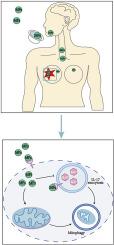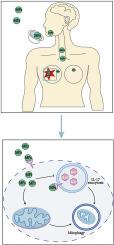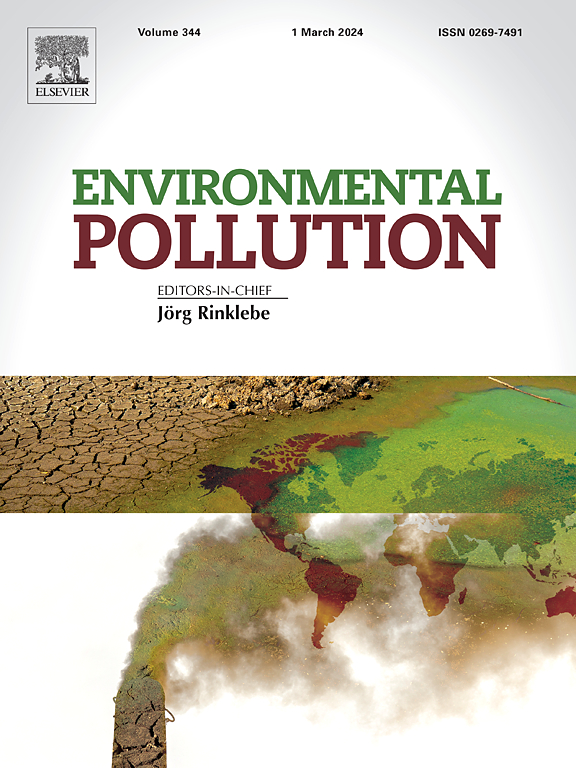乳腺癌患者体内积累的微塑料通过ANXA2介导的内吞和IL-17信号通路导致有丝分裂。
IF 7.6
2区 环境科学与生态学
Q1 ENVIRONMENTAL SCIENCES
引用次数: 0
摘要
乳腺癌(BC)是女性最常见的恶性肿瘤,也是癌症死亡的主要原因。微塑料(MPs)是直径小于 5 毫米的塑料碎片,很容易被生物体摄入。虽然有报道称 MPs 可通过饮食、手术等途径进入人体,但 MPs 是否会在 BC 中蓄积及其影响在很大程度上还不为人所知。我们的研究揭示了 MPs 在 BC 患者样本中的大量积累。MPs牵引实验和质谱(MS)研究表明,MPs与annexin A2(ANXA2)结合并被内吞进入细胞。这一过程导致线粒体损伤,随后诱导有丝分裂。此外,MPs 与 ANXA2 结合后,通过抑制 IL-17 的外排来调节有丝分裂。这些发现揭示了MPs对BC患者的毒性作用机制,阐明了MPs导致线粒体损伤的ANXA2-IL-17信号通路的分子机制,并提出了MPs的潜在毒性作用和毒性机制。本文章由计算机程序翻译,如有差异,请以英文原文为准。


Microplastics accumulated in breast cancer patients lead to mitophagy via ANXA2-mediated endocytosis and IL-17 signaling pathway
Breast cancer (BC) is the most common malignancy in women and the leading cause of cancer death. Microplastics (MPs) are plastic fragments with a diameter of less than 5 mm, easily ingested by organisms. Although MPs have been reported to enter the human body through diet, surgery, etc., whether MPs accumulate in BC and their effects have been largely unknown. Our study revealed a significant accumulation of MPs in BC patient samples. MPs pull-down experiments and mass spectrometry (MS) studies showed that MPs bound to annexin A2 (ANXA2) and were endocytosed into cells. This process resulted in mitochondrial damage and subsequent induction of mitophagy. Furthermore, after binding to ANXA2, MPs regulated mitophagy by inhibiting IL-17 exocytosis. These findings revealed the mechanism of toxic effects of MPs in patients with BC, clarified the molecular mechanism of ANXA2-IL-17 signaling pathway causing mitochondrial damage by MPs, and suggested the potential toxic effects and toxicological mechanisms of MPs.
求助全文
通过发布文献求助,成功后即可免费获取论文全文。
去求助
来源期刊

Environmental Pollution
环境科学-环境科学
CiteScore
16.00
自引率
6.70%
发文量
2082
审稿时长
2.9 months
期刊介绍:
Environmental Pollution is an international peer-reviewed journal that publishes high-quality research papers and review articles covering all aspects of environmental pollution and its impacts on ecosystems and human health.
Subject areas include, but are not limited to:
• Sources and occurrences of pollutants that are clearly defined and measured in environmental compartments, food and food-related items, and human bodies;
• Interlinks between contaminant exposure and biological, ecological, and human health effects, including those of climate change;
• Contaminants of emerging concerns (including but not limited to antibiotic resistant microorganisms or genes, microplastics/nanoplastics, electronic wastes, light, and noise) and/or their biological, ecological, or human health effects;
• Laboratory and field studies on the remediation/mitigation of environmental pollution via new techniques and with clear links to biological, ecological, or human health effects;
• Modeling of pollution processes, patterns, or trends that is of clear environmental and/or human health interest;
• New techniques that measure and examine environmental occurrences, transport, behavior, and effects of pollutants within the environment or the laboratory, provided that they can be clearly used to address problems within regional or global environmental compartments.
 求助内容:
求助内容: 应助结果提醒方式:
应助结果提醒方式:


